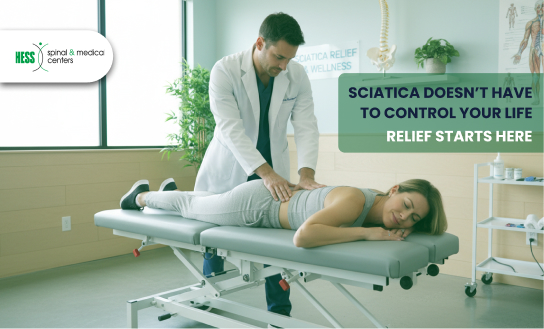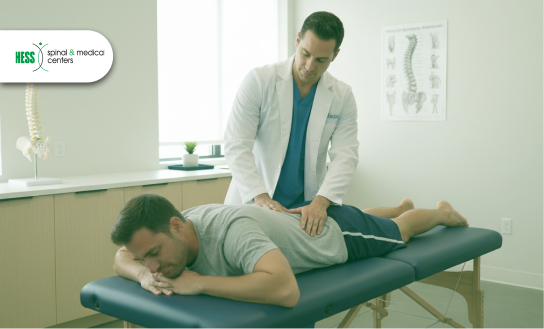
Can a Chiropractor Help with TMJ or Jaw Pain?
Chiropractic Manipulation
November 8, 2025
Can a Chiropractor Help with TMJ or Jaw Pain?

I never thought TMJ or jaw pain could take over someone’s life until I met a patient who could barely chew without wincing. At first, they blamed stress, or maybe a toothache, yet the more I looked, the clearer it became that their jaw wasn’t the real problem. The tension in their neck, the misalignment in their upper spine, even the way they sat at their desk all played a part in what they were feeling.
TMJ pain isn’t just about your jaw, and most people don’t realize how connected it is to the rest of the body. After years of helping patients, I’ve seen the difference that precise, gentle chiropractic care can make the most surprising results often come from a place nobody expects.
1. The Hidden Link Between the Jaw and Spine
When I talk to patients about TMJ, I always start with the basics. The temporomandibular joint is the hinge connecting your lower jaw to your skull, right in front of your ears. It might seem small and simple; however, it’s actually one of the most complex and sensitive joints in the body.
It moves every time you talk, chew, or even yawn, and it works in perfect harmony with dozens of muscles, ligaments, and nerves. When even a small misalignment occurs, that delicate harmony is disrupted, often causing clicking, popping, or pain when opening or closing the mouth.
What most people don’t realize is how much the jaw relies on the rest of the body. The alignment of your neck and upper spine directly influences how the TMJ functions. I’ve seen patients who have spent years focusing on their jaw alone, only to discover that a small misalignment in their cervical spine was the real culprit.
When the spine is out of alignment, the muscles that control the jaw have to compensate unevenly. That tension builds over time, creating pain, neck stiffness, making you unable to chew or speak, reducing your range of motion, and sometimes making it difficult to move or causing lockjaw.
2. Chiropractic Care Can Relieve TMJ and Jaw Pain

TMJ disorders, which affect the jaw joint, and general jaw pain are closely related but not identical conditions. That means how chiropractic care helps can look a little different for each person. What I’ve noticed over the years is that real relief comes from looking at the whole system, not just the jaw itself.
One of the first steps is gentle adjustments to the jaw, neck, and upper spine. Misalignments in these areas can put pressure on the TMJ, making it sore and stiff. By carefully realigning the spine and jaw, movement becomes smoother, and pressure that’s been building up for months or years begins to ease.
Muscle tension plays a huge role too. The jaw, neck, and shoulders often carry stress, especially if you grind your teeth or spend long hours at a desk. Soft tissue therapies like myofascial release or trigger point work help relax these tight muscles, making the jaw feel lighter and easier to move.
Posture matters more than most people realize. A forward head or rounded shoulders might seem unrelated to jaw pain, yet they increase strain on the TMJ. Adjusting posture can reduce this tension, while also supporting better alignment in the neck and upper back.
There’s also a nervous system benefit. Misaligned vertebrae can interfere with the signals traveling to the muscles that control your jaw. By restoring alignment, chiropractic care helps your nerves communicate properly, which supports natural healing and improved function.
Chiropractors may also guide you through exercises to strengthen jaw muscles, improve mobility, and reduce habits like clenching or grinding. Sometimes, adjunct therapies like cold laser treatment or TENS are used to calm inflammation and manage pain.
I remember a patient who had struggled with jaw stiffness and headaches for months. After a few sessions of spinal adjustments, soft tissue therapy, and posture guidance, they could chew comfortably and speak without pain for the first time in months.
Watching the relief spread across their whole body reminded me how interconnected everything is and how chiropractic care can help the jaw feel completely natural again.
3. What to Expect at Hess Spinal Medical Center

The first time you come to our medical center, we focus on understanding you and your jaw pain, not just performing an adjustment.
We start with a detailed conversation about your symptoms, your lifestyle, and your health goals. For example, how jaw pain is affecting your certain activity like chewing, talking, or even sleeping and what you hope to achieve with chiropractic care.
After that, we perform a thorough physical examination, including
Checking your jaw’s motion range.
Assessing the jaw alignment and cervical spine.
Palpating the muscles around the jaw, neck, and shoulders.
This helps to identify tension or misalignment. In some cases, we may take X-rays to get a clearer picture of the jaw and spine, though this isn’t always necessary.
Once I understand your condition, I create a personalized treatment plan tailored to how your jaw and spine interact. Many patients begin with their first gentle adjustment during this initial visit, while others may start with soft tissue work to release tight muscles. Treatments often include
Precise spinal and jaw adjustments to relieve stress on the TMJ.
Manual therapies like myofascial release or deep tissue work to ease tension.
Guided exercises to strengthen the jaw muscles and improve flexibility.
Depending on the case, additional modalities such as electrical muscle stimulation, cold laser therapy, or ultrasound may be suggested to manage pain and inflammation.
I also provide advice on lifestyle adjustments, including stress management, since clenching or grinding can make TMJ pain worse. Even small changes, combined with regular treatment, can significantly reduce discomfort and prevent future flare-ups.
At our medical center, the goal is always long-term comfort and improved function. Jaw pain isn’t just a minor inconvenience, as it affects the way you move, eat, and live.
If TMJ discomfort or jaw pain has been interfering with your life, I encourage you to schedule a consultation. Together, we can develop a plan that restores balance, eases tension, and helps your jaw and the rest of your body feel natural again.
Get Long-Term Relief for TMJ or Jaw Pain

The ultimate goal is to help your jaw move freely, comfortably, and without tension taking over your daily life. TMJ pain is often tied to how your body functions as a whole, not just your jaw. Chiropractic care works to restore balance, easing the pressure on your joints and muscles so you can speak, chew, and smile without discomfort.
If you have been dealing with persistent jaw stiffness, clicking, or headaches linked to TMJ, it may be time to see how chiropractic adjustments could help. Every case is different, and understanding the source of your pain is the first step toward real relief. Schedule a consultation to evaluate your alignment, muscle tension, and joint health, and take the next step toward restoring comfort and confidence in your everyday life.
Frequently Asked Questions
Q. Can TMJ pain go away on its own?
Mild TMJ discomfort can sometimes be relieved with rest, stress management, and avoidance of habits such as clenching or chewing gum; however, this is not the case if the pain lasts more than a few days.
Q. How long does it take to see results from chiropractic care for TMJ?
That depends on the cause and severity of your condition. Some patients feel noticeable relief after one or two visits, while chronic cases may take several weeks of consistent treatment to fully stabilize.
Q. Are there any side effects of chiropractic care for TMJ?
Side effects are rare and typically mild, such as temporary soreness after an adjustment. These symptoms usually fade quickly as the body adjusts to its improved alignment.
Q. Do chiropractors work with dentists for TMJ treatment?
Yes. When treating complex TMJ symptoms, such as in patients using dental splints, chiropractic care relieves pain and muscle spasms.
Q. Is chiropractic care a permanent fix for TMJ?
It can provide lasting relief when combined with good posture habits, stress control, and follow-up maintenance. TMJ dysfunction tends to recur if its root cause, such as misalignment, muscle tension, or poor posture, isn’t consistently managed.
Q. Can chiropractic care help with TMJ-related headaches or ear pain?
Yes. Because the jaw, neck, and surrounding muscles share nerve pathways, misalignment can cause headaches, ear fullness, or pressure. By addressing the root tension in the neck and jaw, chiropractic care often relieves these secondary symptoms too.
Q. Can chiropractic adjustments prevent future TMJ issues?
While maintaining proper spinal and jaw alignment, chiropractic care helps reduce recurring tension, improves muscle balance, and supports long-term jaw function.
Q. Do I need a referral from a medical doctor to see a chiropractor for TMJ?
No referral is required. You can schedule an appointment directly with a chiropractor at Hess Spinal Medical Center for TMJ evaluation and treatment.
Recent Cases







